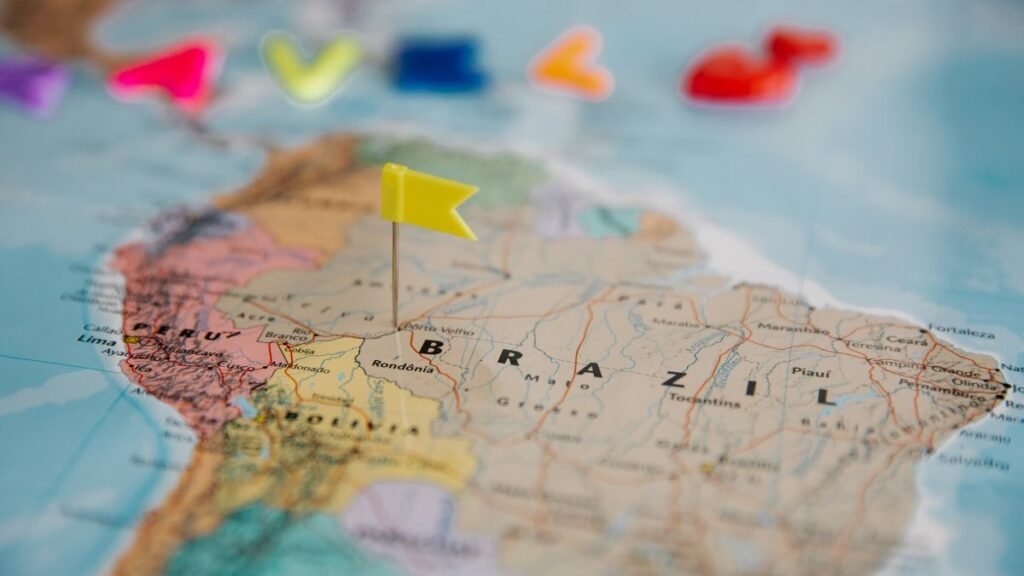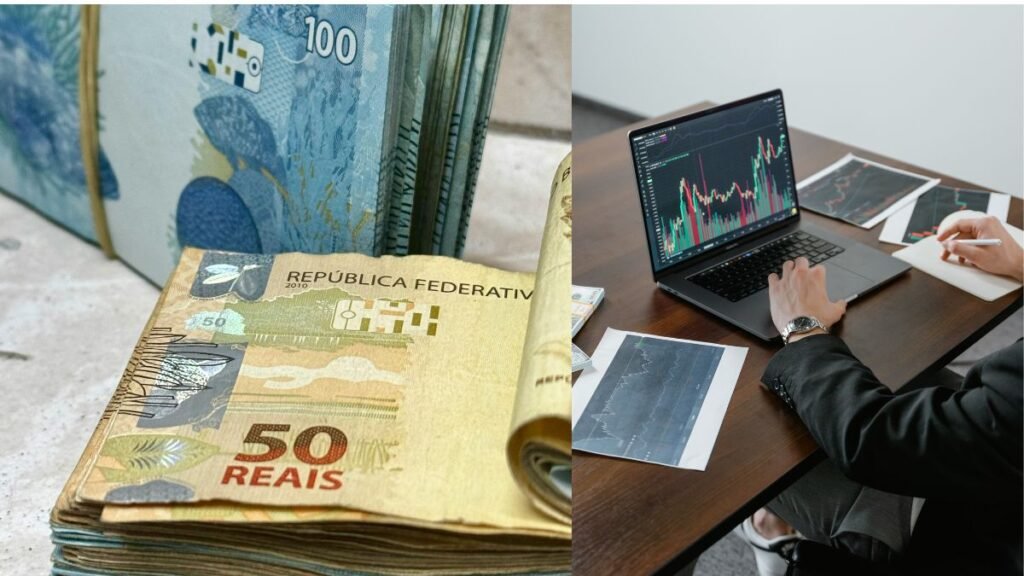Introdução
What if one nation’s past could reveal the secrets behind its dazzling culture and economic strength? This country, known for its lush landscapes and rhythmic beats, holds a story woven from Indigenous roots, African resilience, and European ambition.
The vibrant tapestry of Brazil’s history is not just a tale of survival and adaptation; it is a complex narrative that showcases the fusion of various cultures, each contributing to the nation’s unique identity.
The Indigenous people, with their deep connection to the land, laid the groundwork for a rich cultural heritage. At the same time, the African communities brought resilience and vibrant traditions that enriched the social fabric.
European colonization introduced new ideas and ambitions, further shaping the economic landscape and cultural dynamics of Brazil. Understanding Brazil History reveals how these elements interconnect to form a unique national identity.

Spanning over five centuries, its journey encompasses golden booms, revolutionary movements, and a rise to become a global player. From sugar plantations to modern industries, each era has left its mark on the region’s identity.
With 22 UNESCO World Heritage Sites, the nation stands as a living museum of human achievement. Its blend of traditions creates a unique tapestry unmatched anywhere else.
Key Takeaways
- The fifth-largest nation by size and population, with deep historical roots
- Cultural fusion of Indigenous, African, and European influences
- 13th globally in UNESCO World Heritage Sites
- Economic evolution from sugar/gold to modern industries
- 522+ years of transformative events shaping national identity
Introduction: The Rich Tapestry of Brazil History
Evidence of human life in this region dates back to the last Ice Age, hidden in cave paintings and artifacts. At Serra da Capivara, archaeologists have found traces of settlements dating back to 11,000 BCE, providing evidence of thriving communities long before European contact.
By the time Portuguese explorers arrived, an estimated 2 to 6 million indigenous people were living here. They belonged to over 2,000 distinct tribes, each with its own unique traditions. The Marajoara culture, for example, created intricate pottery 8,000 years ago—some of the oldest in the Americas.
Colonization in the 16th century profoundly reshaped the region’s history. The Treaty of Tordesillas (1494) divided territorial claims between Portugal and Spain, placing this land under Portuguese rule. Their influence remains visible today in the language, Catholic faith, and colonial architecture.
Contact had devastating consequences for native peoples. Diseases and conflict led to a 95% decline in the population. Yet their legacy endures in place names, foods, and cultural practices.
The economy soon relied on enslaved African labor. Over 4 million people were forcibly transported across the Atlantic, a painful foundation for the nation’s growth. This complex past forged a society unlike any other.
The Colonial Foundations (1500-1822)
A disputed landing in 1500 marked the start of three centuries of colonial transformation. While Pedro Álvares Cabral is credited with the discovery, evidence suggests Duarte Pereira may have reached the land in 1498. This debate underscores Europe’s scramble for new territories.
Pedro Álvares Cabral’s Arrival and Early Settlements
Cabral’s fleet, bound for India, drifted westward unexpectedly due to navigational errors and the winds of the Atlantic.
His arrival in 1500 marked a pivotal moment, beginning Portugal’s claim to vast territories in the New World, but early settlements faced numerous challenges. The captaincy system (1534), designed to promote colonization by granting land to private individuals, struggled to establish a stable presence.
Many settlers were unprepared for the harsh realities of the land, including hostile relations with Indigenous peoples and the difficulty of cultivating crops in unfamiliar terrain. This led to high mortality rates and a lack of sustainable growth, forcing the crown to centralize power in Salvador by 1549, where a more organized colonial administration could better manage resources and defend against external threats.
The Sugar and Gold Cycles: Economic Pillars
Sugar plantations dominated the 16th–17th centuries, fueled by enslaved labor, which became the backbone of the colonial economy. By the 1690s, the discovery of gold and diamonds in the mountainous region of Minas Gerais had shifted wealth inland, dramatically altering the economic landscape. Exports soared, reaching 30,000 lbs of gold annually at their peak, transforming Brazil into a significant player in the global market.
The influx of wealth from these resources not only enriched the colonial elite but also contributed to the establishment of a complex social hierarchy, where power and privilege were concentrated among a small number of landowners and merchants, further entrenching the reliance on enslaved labor to maintain production levels.
| Resource | Period | Impact |
|---|---|---|
| Sugar | 1532–1700 | Built coastal aristocracy, establishing a wealthy elite that controlled trade and resources |
| Gold | 1690s–1800 | Moved capital to Rio (1763), facilitating better trade routes and administration |
“The bandeirantes hunted souls as fiercely as they hunted gold.” Jesuit missionary Manuel da Nóbrega
The Brutal Legacy of African Slavery
Indigenous slaves were replaced by Africans after 1570 due to disease resistance, which devastated the native population and led to a dire need for labor on plantations. The influx of African slaves marked a significant shift in the demographic and cultural landscape of Brazil.
Mortality rates reached 40% on sugar plantations, a staggering figure that underscores the brutal conditions and relentless exploitation faced by these individuals. By 1800, over 4 million had been forcibly transported; their cultural imprint remains indelible, influencing music, religion, and social practices that persist to this day.
Rio’s 1763 elevation as capital reflected the colony’s economic priorities, showcasing the wealth generated from slave labor and the sugar trade. Yet beneath the wealth lay a society fractured by exploitation, where the suffering of enslaved people was often ignored by the elite.
This deep-rooted inequality set the stage for future upheavals, as the harsh realities of slavery created a growing tension that would eventually contribute to calls for abolition and social reform.
The Struggle for Independence (1822)
Napoleon’s European conquests triggered a royal migration that reshaped South America. When French forces invaded Portugal in 1807, the entire court fled to Rio de Janeiro, the only European monarchy to ever rule from the colonies. This unprecedented move laid the groundwork for a new era.
King João VI transformed Rio into a thriving capital during his 13-year stay. He established:
- The National Bank, South America’s first
- Royal printing presses for newspapers
- Medical and law schools
Dom Pedro I’s Defiance of Portugal
When João VI returned to Lisbon in 1821, he left his son Pedro as regent. Portuguese leaders demanded Brazil’s return to colonial status, sparking outrage. Pedro’s famous “Fico” speech in January 1822 marked his refusal to leave.
The crisis escalated when 13,000 Portuguese troops arrived. On September 7, 1822, Pedro drew his sword at Ipiranga and shouted, “Independence or Death!” This dramatic moment, now celebrated as Independence Day, marked the establishment of the only monarchy in the Americas.
“The Brazilian people want me to stay—I will stay.” Dom Pedro I, January 9, 1822
The Birth of the Brazilian Empire
Unlike violent revolutions elsewhere, this independence came through political maneuvering. The United States recognized the new empire in 1824, with Portugal following in 1825 after the Treaty of Rio de Janeiro.
The young nation faced immediate challenges. The costly Cisplatine War (1825–1828) resulted in Uruguay’s independence, straining the treasury. Yet Pedro I’s bold actions created a sovereign state that would endure for centuries.
The Rise and Fall of the Monarchy (1822-1889)
Under a child emperor’s rule, the nation navigated revolutions and reforms. Dom Pedro II took the throne at age five in 1831, beginning a 58-year reign marked by stability and progress. Despite regional rebellions, his leadership modernized infrastructure, education, and government systems.
Dom Pedro II’s Modernizing Reign
The 1850 Land Law established private property rights, reshaping rural economies. Pedro II’s love for science and diplomacy earned global respect. He connected cities with railroads and backed abolitionist causes, though cautiously.
“I was born to serve my people, not to be served by them.” Dom Pedro II
Princess Isabel and the Abolition of Slavery
By 1888, enslaved laborers still accounted for 6.4% of the GDP. When Princess Isabel signed the Golden Law, 700,000 gained freedom, without compensation to planters. Coffee barons, furious at losing power, joined military factions plotting regime change.
| Year | Event | Impact |
|---|---|---|
| 1850 | Land Law | Consolidated elite landholdings |
| 1888 | Golden Law | Abolished slavery, alienated planters |
| 1889 | November 15 Coup | Monarchy overthrown |
The 1889 coup, led by Deodoro da Fonseca, ended imperial rule in a matter of hours. European immigrants soon filled labor gaps—2.5 million arrived between 1870 and 1914. The republic’s birth signaled a turbulent new chapter.
The Coffee Boom and the Old Republic (1889-1930)
Golden coffee beans fueled an economic revolution that reshaped power structures. By 1900, the crop accounted for 73% of exports, making São Paulo a global leader. Production skyrocketed from 1.3 million bags in 1850 to 16 million by 1900—a 1,130% surge.
From Monarchy to Military-Backed Rule
The 1891 Constitution restricted voting to 2.2% of the population, entrenching elite control. Rural coronelismo systems let local bosses trade votes for favors, while urban centers like Rio were modernized with the 1904 reforms. The Canudos War (1897) exposed stark inequality—30,000 impoverished rebels faced brutal suppression.
Coffee Barons and Economic Expansion
To stabilize prices, the Taubaté Agreement (1906) introduced coffee valorization, whereby the state purchased surplus beans to increase their value. This scheme temporarily saved planters but deepened the debt. Meanwhile, European immigrants replaced enslaved labor, with 2.5 million arriving by 1914.
“Coffee is not just a crop; it’s the bloodstream of our republic.” Paulista planter, 1903
The era’s legacy? A nation torn between progress and exclusion, where wealth flowed as freely as coffee, but power remained in a few hands.
The Vargas Era and Industrialization (1930-1945)
A political earthquake shook the nation in 1930 when Getúlio Vargas seized power through a bloodless coup. His rise marked the end of the coffee oligarchs’ dominance and began a transformative period. For 15 turbulent years, Vargas reshaped the government, economy, and national identity.

Getúlio Vargas’ Populist Dictatorship
The 1932 Constitutionalist Revolution saw São Paulo rebels fight Vargas’ centralization, and lose. By 1937, he declared the Estado Novo, dissolving Congress and ruling by decree. This control lasted until 1945, a period marked by a mix of repression and progress.
Key policies emerged:
- State-led industrialization replaced coffee dependence
- Petrobras, the oil company, was founded in 1953 for energy independence
- Radio broadcasts unified national culture
“I leave life to enter history.” Getúlio Vargas’ suicide note, 1954
Labor Reforms and National Identity
The 1943 CLT labor laws revolutionized worker rights, and many of these provisions still apply today. Minimum wage, paid leave, and safety standards emerged. Meanwhile, 25,000 troops fought alongside the Allies in Italy during World War II, earning global respect.
Vargas’ legacy remains complex. His policies modernized infrastructure but came with censorship and political arrests. The era proved nations could industrialize rapidly, yet at what cost to freedom?
Military Dictatorship and the “Economic Miracle” (1964-1985)
Dark clouds gathered over the nation as tanks rolled through its capital in 1964. The military coup, backed by the U.S. through Operation Brother Sam, ousted the left-leaning President João Goulart. What followed was 21 years of authoritarian rule, masked by rapid growth but marred by brutality.
The 1964 Coup and Repression
Over 434 dissidents “disappeared” under regime surveillance. Censorship spiked: 500 films banned, 200 journalists exiled. The 1968 Institutional Act No. 5 suspended habeas corpus, enabling the torture of political opponents.
“They came in the night, took my son, and left no trace.” Mother of a disappeared student, 1971
Pharaonic Projects and Inflation Crisis
The economy grew 10% annually (1968–1973), dubbed the “Miracle.” Yet mega-projects like the 4,000 km Transamazonian Highway drained resources. The Itaipu Dam, a $20 billion endeavor, symbolized misplaced priorities.
Finance Minister Delfim Neto’s “cake theory” argued that growth must precede redistribution. By 1985, inflation hit 235%, eroding wages. The world watched as protests, like the 1968 Hundred Thousand March, demanded democracy.
| Year | Event | Impact |
|---|---|---|
| 1979 | Amnesty Law | Freed political prisoners but shielded torturers |
| 1985 | Regime Collapse | Civilian rule restored after mass protests |
Redemocratization and Economic Turbulence (1985-2002)
Democracy returned, bringing both hope and hurdles, in the late 20th century. The 1989 elections marked the first direct presidential vote in 29 years, won by Fernando Collor. His administration soon faced allegations of corruption that would shake the nation.

The Impeachment of Fernando Collor
Collor’s presidency collapsed in 1992 amid the PC Farias scandal. Investigators revealed a $800 million corruption scheme involving his campaign treasurer. Massive street protests, featuring painted faces (caras-pintadas), demanded accountability.
“The people have awakened—we won’t tolerate thieves in power.” Protest leader during impeachment
Congress voted 441-38 to remove the president, marking Latin America’s first presidential impeachment. Vice President Itamar Franco took office, facing an annual inflation rate of 2,477%. The crisis demanded radical solutions.
The Plano Real and Stabilization
Economist Fernando Henrique Cardoso launched the Plano Real in 1994. The bold reform replaced the cruzeiro with a new currency pegged to the US dollar. Inflation plummeted from quadruple digits to 6% within a year.
Key measures included:
- Strict monetary controls by the Central Bank
- Gradual currency introduction to build trust
- Tax reforms to balance budgets
The plan’s success propelled Cardoso to the presidency. His 1998 IMF deal secured a $41.5 billion package during the Asian financial crisis. However, the real suffered a 35% devaluation in 1999.
Amidst economic turmoil, soccer provided a source of national pride. The 1994 World Cup victory, led by Romário and Bebeto, boosted morale. Eight years later, the “Three R’s” (Ronaldo, Rivaldo, Ronaldinho) secured a fifth championship.
Rural conflicts intensified as the Landless Workers’ Movement (MST) gained strength. Founded in 1984, it organized farm occupations demanding the redistribution of land. These tensions revealed the uneven distribution of benefits from economic reforms.
Modern Brazil: Challenges and Global Ambitions (2002-Present)
The 21st century brought both breakthroughs and crises to this rising global power. Economic growth lifted millions out of poverty, while political turmoil tested democratic institutions. On the world stage, the nation struck a balance between environmental leadership and ambitious infrastructure projects.
Political Scandals and Environmental Leadership
Operation Car Wash (2014-2021) exposed systemic corruption, recovering $2 billion in embezzled funds. The investigation implicated hundreds of politicians and business leaders, including former president Dilma Rousseff, who was impeached in 2016.
Environmental policies showed contrasting results:
| Year | Initiative | Impact |
|---|---|---|
| 2008 | Amazon Fund | $1.3 billion for conservation |
| 2023 | Deforestation Control | 66% reduction from 2004 peak |
Recent administrations have strengthened ties with the United States while leading the expansion of the BRICS economic bloc. As the nation addresses inequality and climate change today, its journey continues to captivate global observers.
Conclusion: Brazil’s Unfinished Journey
Five centuries of transformation have shaped a nation of contrasts and resilience, a rich tapestry of Brazil history. Indigenous, African, and European roots fused into a vibrant culture, yet income inequality persists, with a Gini index of 53.4 in 2023.
The country balances environmental stewardship with development pressures. While deforestation rates dropped 66% since 2004, debates over Amazon infrastructure continue.
Globally, its role expands—leading UN peacekeeping missions like Haiti’s MINUSTAH. The 21st century demands solutions for urban poverty and sustainable growth.
Initiatives like the 2025 UNESCO elephant sanctuary symbolize progress. For its people, the journey remains unfinished, but the path forward blends tradition with innovation. Learn more Brazil Geography
FAQ
When did the country gain independence?
The nation declared independence on September 7, 1822, under the leadership of Dom Pedro I, breaking away from Portuguese rule.
What were the main economic drivers during colonial times?
Sugar and gold dominated the economy, followed by coffee, which later fueled industrialization.
How did slavery shape early society?
Enslaved Africans built plantations and mines, leaving a lasting cultural and social impact despite brutal conditions.
Who played a key role in ending slavery?
Princess Isabel signed the Golden Law in 1888, which abolished slavery but triggered political upheaval.
What caused the fall of the monarchy?
Military leaders and coffee elites ousted Emperor Dom Pedro II in 1889, establishing a republic.
How did Getúlio Vargas influence modernization?
His dictatorship (1930–1945) introduced labor rights and industrial policies, reshaping national identity.
What marked the military dictatorship era?
The 1964 coup brought repression and censorship, followed by an economic boom that ultimately led to the crisis.
How did democracy return in the 1980s?
Mass protests and failing policies compelled the military to relinquish power, paving the way for free elections.




